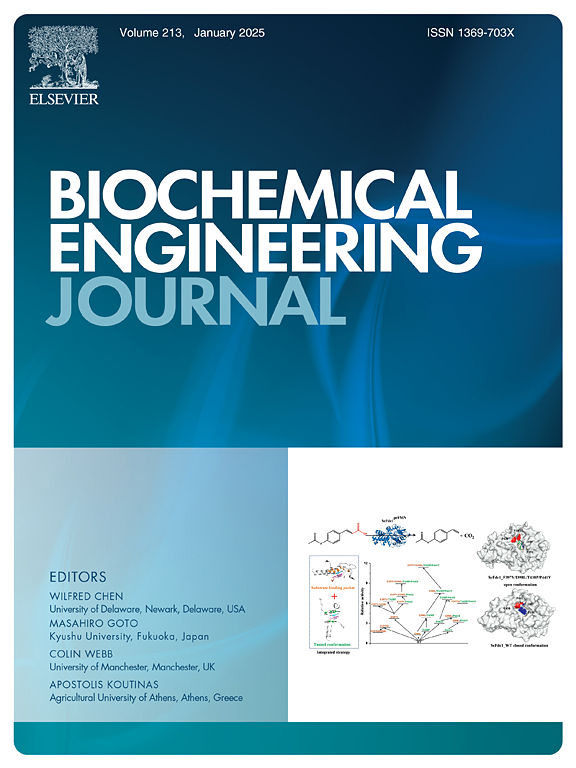在深共熔溶剂中制备的Zr-MOF上共固定蜗牛酶和β-糖苷酶,使人参皂苷Rb1转化为CK
IF 3.7
3区 生物学
Q2 BIOTECHNOLOGY & APPLIED MICROBIOLOGY
引用次数: 0
摘要
锆基金属有机骨架(Zr-MOF)稳定且易于功能化,但其合成存在环境友好性差、传质受限等问题,限制了其应用。本研究以丙酸(PA)为改性剂,采用胆碱基深共晶溶剂(DES)代替传统溶剂。在短短6 h内,我们成功地制造了缺陷数为0.7719的球形UNP-66生物复合材料。然后用戊二醛将蜗牛酶(Sna)和β-糖苷酶(β-G)共价连接到载体上,制备固定化酶。酶载量为158 mg/g。DES加快了合成速度,降低了酶活性损失。固定化酶具有良好的热稳定性、pH稳定性和贮存稳定性。它能有效地催化Rb1转化为CK, CK收率为77.23 %。经过6次循环后,其相对酶活性仍保持在初始水平的72.82 %。这种基于des的缺陷MOF合成方法具有显著的优势,为绿色高效制备高价值天然产物开辟了一条新途径。本文章由计算机程序翻译,如有差异,请以英文原文为准。
Bioconversion of ginsenoside Rb1 to CK by co-immobilizing snailase and β-glycosidase on Zr-MOF prepared in the deep eutectic solvent
Zirconium-based metal-organic frameworks (Zr-MOF) are stable and easily functionalized, yet their synthesis has issues like poor environmental friendliness and restricted mass transfer, limiting applications. In this study, we used choline-based deep eutectic solvents (DES) instead of traditional solvents, with propionic acid (PA) as a modifier. In just 6 h, we successfully created a spherical UNP-66 biocomposite with a defect number of 0.7719. We then prepared an immobilized enzyme by covalently attaching snailase (Sna) and β-glycosidase (β-G) to the carrier using glutaric dialdehyde. It had an enzyme-loading capacity of 158 mg/g. DES sped up the synthesis and reduced enzyme-activity loss. The immobilized enzyme showed good thermal, pH, and storage stability. It efficiently catalyzed Rb1 to CK conversion, with a CK yield of 77.23 %. After 6 cycles, it retained 72.82 % of its initial relative enzyme activity. This DES-based defective MOF synthesis method has significant advantages, opening a new path for green, efficient preparation of high-value natural products.
求助全文
通过发布文献求助,成功后即可免费获取论文全文。
去求助
来源期刊

Biochemical Engineering Journal
工程技术-工程:化工
CiteScore
7.10
自引率
5.10%
发文量
380
审稿时长
34 days
期刊介绍:
The Biochemical Engineering Journal aims to promote progress in the crucial chemical engineering aspects of the development of biological processes associated with everything from raw materials preparation to product recovery relevant to industries as diverse as medical/healthcare, industrial biotechnology, and environmental biotechnology.
The Journal welcomes full length original research papers, short communications, and review papers* in the following research fields:
Biocatalysis (enzyme or microbial) and biotransformations, including immobilized biocatalyst preparation and kinetics
Biosensors and Biodevices including biofabrication and novel fuel cell development
Bioseparations including scale-up and protein refolding/renaturation
Environmental Bioengineering including bioconversion, bioremediation, and microbial fuel cells
Bioreactor Systems including characterization, optimization and scale-up
Bioresources and Biorefinery Engineering including biomass conversion, biofuels, bioenergy, and optimization
Industrial Biotechnology including specialty chemicals, platform chemicals and neutraceuticals
Biomaterials and Tissue Engineering including bioartificial organs, cell encapsulation, and controlled release
Cell Culture Engineering (plant, animal or insect cells) including viral vectors, monoclonal antibodies, recombinant proteins, vaccines, and secondary metabolites
Cell Therapies and Stem Cells including pluripotent, mesenchymal and hematopoietic stem cells; immunotherapies; tissue-specific differentiation; and cryopreservation
Metabolic Engineering, Systems and Synthetic Biology including OMICS, bioinformatics, in silico biology, and metabolic flux analysis
Protein Engineering including enzyme engineering and directed evolution.
 求助内容:
求助内容: 应助结果提醒方式:
应助结果提醒方式:


